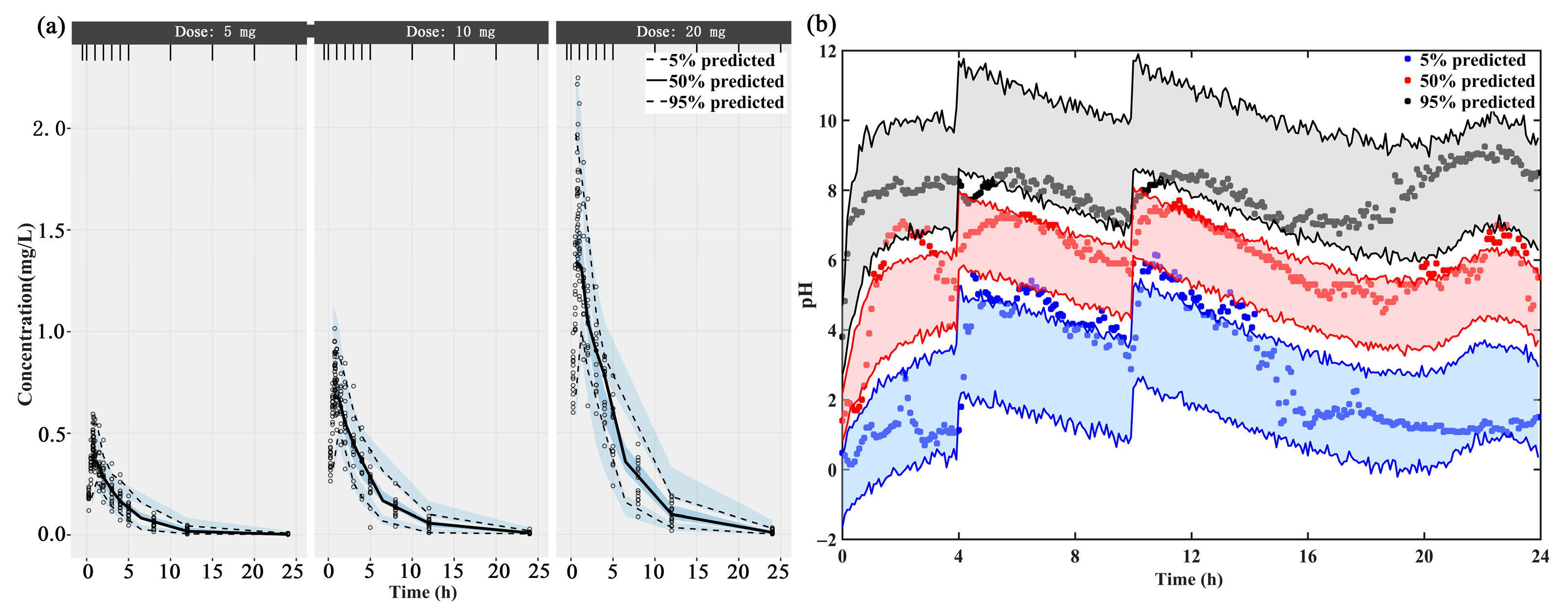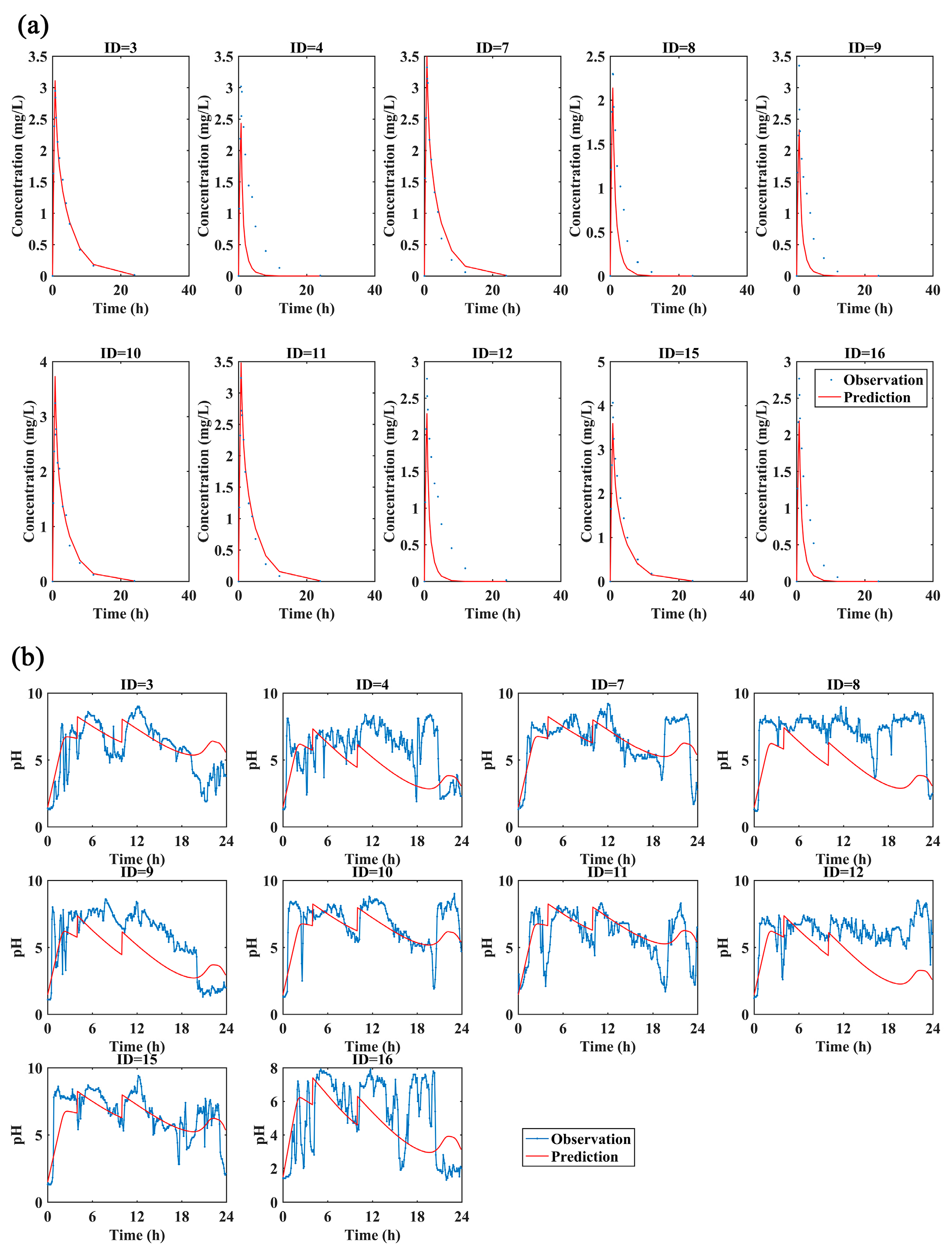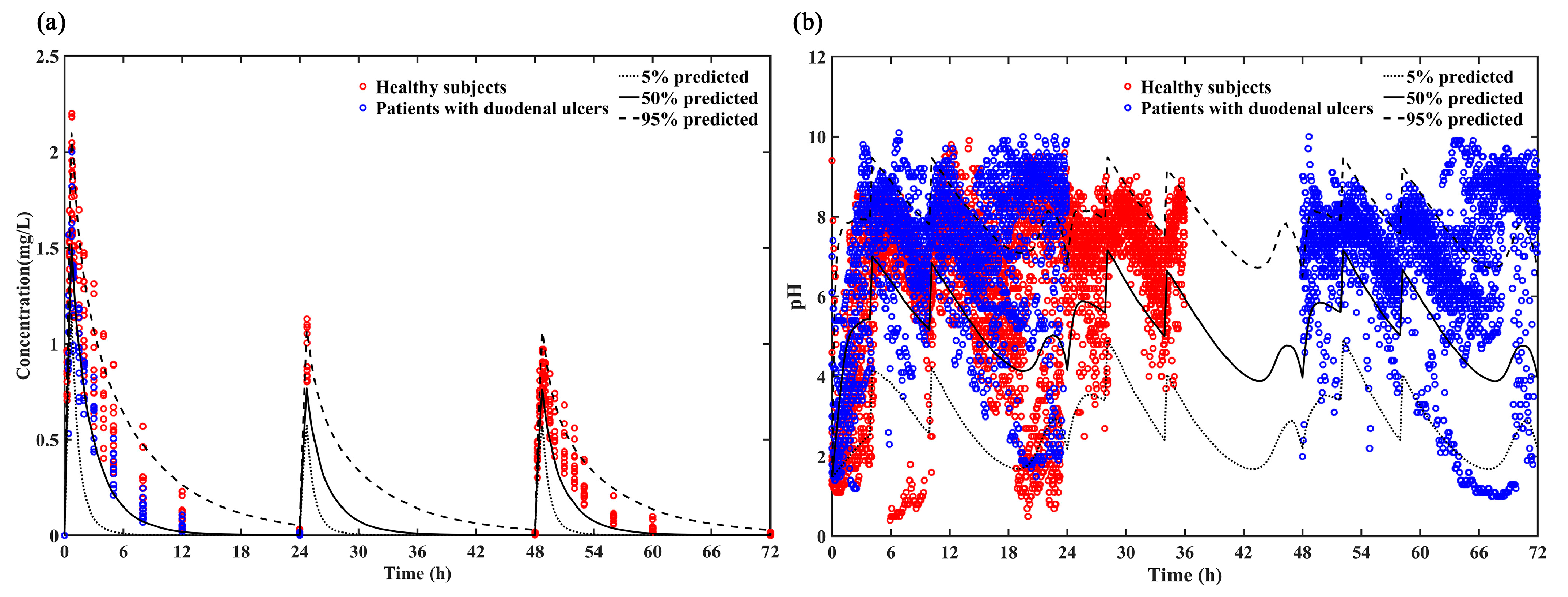Accelerating Development of Benziamidazole-Class Proton Pump Inhibitors: A Mechanism-Based PK/PD Model to Optimize Study Design with Ilaprazole as a Case Drug
Abstract
1. Introduction
2. Materials and Methods
2.1. Date Source
2.2. Methodology
2.3. Pharmacokinetic Modeling
2.4. Pharmacodynamics Modeling
2.5. Model Evaluation and Validation
2.6. Investigation of the “Ceiling Effect” of Ilaprazole
2.7. Optimization of Dose Regimens
3. Results
3.1. PK Model Development and Estimation
3.2. PD Model Development and Estimation
3.3. Model Evaluation and Validation
3.4. Investigation of the “Ceiling Effect” of Ilaprazole
3.5. Optimization of Dose Regimens
4. Discussion
4.1. Establishment and Validation of the Mechanism-Based PK/PD Model
4.2. Assessment of the Mechanism-Based PK/PD Model under a Wide Range of Dosing Regimens
4.3. Investigation of the Potential “Ceiling Effect” of PPIs
4.4. Optimization of Dose Regimens
5. Conclusions
Supplementary Materials
Author Contributions
Funding
Institutional Review Board Statement
Informed Consent Statement
Data Availability Statement
Acknowledgments
Conflicts of Interest
References
- Sifrim, D.; Zerbib, F. Diagnosis and management of patients with reflux symptoms refractory to proton pump inhibitors. Gut 2012, 61, 1340–1354. [Google Scholar] [CrossRef]
- Strand, D.S.; Kim, D.; Peura, D.A. 25 Years of Proton Pump Inhibitors: A Comprehensive Review. Gut Liver 2017, 11, 27–37. [Google Scholar] [CrossRef] [PubMed]
- Kinoshita, Y.; Ishimura, N.; Ishihara, S. Advantages and Disadvantages of Long-term Proton Pump Inhibitor Use. J. Neurogastroenterol. Motil. 2018, 24, 182–196. [Google Scholar] [CrossRef] [PubMed]
- Puchalski, T.A.; Krzyzanski, W.; Blum, R.A.; Jusko, W.J. Pharmacodynamic modeling of lansoprazole using an indirect irreversible response model. J. Clin. Pharmacol. 2001, 41, 251–258. [Google Scholar] [CrossRef] [PubMed]
- Liu, N.; Yang, H.; Jiang, J.; Nagy, P.; Shen, K.; Qian, J.; Hu, P. Pharmacokinetic and Pharmacodynamic Modeling Analysis of Intravenous Esomeprazole in Healthy Volunteers. J. Clin. Pharmacol. 2016, 56, 816–826. [Google Scholar] [CrossRef]
- Eun Joo, K.; Rae Kyong, L.; Seung Mok, L.; Dong Yeon, K. General pharmacology of IY-81149, a new proton pump inhibitor. Arzneim. Forsch. Drug Res. 2001, 51, 51–59. [Google Scholar]
- Kwon, D.; Chae, J.; Park, C.; Kim, Y.; Lee, S.; Kim, E.; Huh, I.; Kim, N.; Cho, K. Effects of IY-81149, a Newly Developed Proton Pump Inhibitor, on Gastric Acid Secretion in vitro and in vivo. Arzneimittelforschung 2001, 51, 204–213. [Google Scholar] [CrossRef] [PubMed]
- Seo, K.-A.; Lee, S.-J.; Kim, K.-B.; Bae, S.K.; Liu, K.-H.; Kim, D.-H.; Shin, J.-G. Ilaprazole, a new proton pump inhibitor, is primarily metabolized to ilaprazole sulfone by CYP3A4 and 3A5. Xenobiotica 2012, 42, 278–284. [Google Scholar] [CrossRef]
- Li, Y.; Zhang, W.; Guo, N.; Zhou, G.; Zhou, H.; Xiao, Z. Pharmacokinetics of the new proton pump inhibitor ilaprazole in Chinese healthy subjects in relation to CYP3A5 and CYP2C19 genotypes. Clin. Chim. Acta 2008, 391, 60–67. [Google Scholar] [CrossRef]
- Cho, H.; Choi, M.-K.; Cho, D.-Y.; Yeo, C.-W.; Jeong, H.-E.; Shon, J.-H.; Lee, J.-Y.; Shin, J.-S.; Cho, M.; Kim, D.-Y.; et al. Effect of CYP2C19 Genetic Polymorphism on Pharmacokinetics and Pharmacodynamics and Pharmacodynamics of a New Proton Pump Inhibitor, Ilaprazole. J. Clin. Pharmacol. 2012, 52, 976–984. [Google Scholar] [CrossRef] [PubMed]
- Wang, H.; Shao, F.; Liu, X.; Xu, W.; Ou, N.; Qin, X.; Liu, F.; Hou, X.; Hu, H.; Jiang, J. Efficacy, safety and pharmacokinetics of ilaprazole infusion in healthy subjects and patients with esomeprazole as positive control. Br. J. Clin. Pharmacol. 2019, 85, 2547–2558. [Google Scholar] [CrossRef] [PubMed]
- Ji, X.-Q.; Du, J.-F.; Chen, G.; Yu, B.; Chen, G. Efficacy of ilaprazole in the treatment of duodenal ulcers: A meta-analysis. World J. Gastroenterol. 2014, 20, 5119–5123. [Google Scholar] [CrossRef] [PubMed]
- Wang, H.; Ou, N.; Lang, L.; Shi, R.; Hu, P.; Jiang, J. Pharmacokinetics and pharmacodynamics of intravenous ilaprazole in healthy subjects after single ascending doses. Xenobiotica 2016, 46, 1133–1141. [Google Scholar] [CrossRef] [PubMed]
- Wang, H.; Lang, L.; Ou, N.; Shi, R.; Hu, H.; Hu, P.; Jiang, J. Pharmacokinetics, Pharmacodynamics and Safety of Multiple-Infusion Ilaprazole in Healthy Chinese Subjects. Clin. Drug Investig. 2016, 36, 463–470. [Google Scholar] [CrossRef] [PubMed]
- Cao, S.; Zhou, G.; Chen, Y.; Guo, N.; Tan, Z.-R.; Fan, L.; Hu, H.-T.; Qin, X.-H.; Ouyang, D.-S.; Zhang, W. Gender, but Not CYP2C19 Genotypes and CYP3A Phenotypes, is a Major Determinant of Ilaprazole Pharmacokinetic. Am. J. Life Sci. 2015, 3, 14. [Google Scholar] [CrossRef][Green Version]
- Lönnebo, A.; Grahnén, A.; Karlsson, M.O. An integrated model for the effect of budesonide on ACTH and cortisol in healthy volunteers. Br. J. Clin. Pharmacol. 2007, 64, 125–132. [Google Scholar] [CrossRef]
- Krzyzanski, W.; Chakraborty, A.; Jusko, W.J. Algorithm for application of fourier analysis for biorhythmic baselines of pharmacodynamic indirect response models. Chronobiol. Int. 2000, 17, 77–93. [Google Scholar] [CrossRef]
- Hersey, S.J.; Sachs, G. Gastric acid secretion. Physiol. Rev. 1995, 75, 155–189. [Google Scholar] [CrossRef]
- Shin, J.M.; Kim, N. Pharmacokinetics and Pharmacodynamics of the Proton Pump Inhibitors. J. Neurogastroenterol. Motil. 2013, 19, 25–35. [Google Scholar] [CrossRef]
- Van Duijn, B.; Ypey, D.L.; De Goede, J.; Verveen, A.A.; Hekkens, W. A model study of the regulation of gastric acid secretion. Am. J. Physiol. Content 1989, 257, G157–G168. [Google Scholar] [CrossRef]
- Dayneka, N.L.; Garg, V.; Jusko, W.J. Comparison of four basic models of indirect pharmacodynamic responses. J. Pharmacokinet. Biopharm. 1993, 21, 457–478. [Google Scholar] [CrossRef] [PubMed]
- Shin, J.S.; Lee, J.Y.; Cho, K.H.; Park, H.L.; Kukulka, M.; Wu, J.-T.; Kim, D.Y.; Park, S.-H. The pharmacokinetics, pharmacodynamics and safety of oral doses of ilaprazole 10, 20 and 40 mg and esomeprazole 40 mg in healthy subjects: A randomised, open-label crossover study. Aliment. Pharmacol. Ther. 2014, 40, 548–561. [Google Scholar] [CrossRef] [PubMed]
- Andersson, T.; Holmberg, J.; Röhss, K.; Walan, A. Pharmacokinetics and effect on caffeine metabolism of the proton pump inhibitors, omeprazole, lansoprazole, and pantoprazole. Br. J. Clin. Pharmacol. 1998, 45, 369–375. [Google Scholar] [CrossRef] [PubMed]
- Yu, L.Y.; Sun, L.N.; Zhang, X.H.; Li, Y.Q.; Yu, L.; Yuan, Z.Q.; Meng, L.; Zhang, H.W.; Wang, Y.Q. A Review of the Novel Application and Potential Adverse Effects of Proton Pump Inhibitors. Adv. Ther. 2017, 34, 1070–1086. [Google Scholar] [CrossRef] [PubMed]
- Pu, J.; Wang, F.; Tang, W.; Zhu, M. Biotransformation of ilaprazole in human liver microsomes and human: Role of CYP3A4 in ilaprazole clearance and drug-drug interaction S. Drug Metab. Dispos. 2018, 46, 1453–1461. [Google Scholar] [CrossRef] [PubMed]





| Parameter | Unit | Definition | Estimate | 95CI% | η |
|---|---|---|---|---|---|
| CLp | L/h | Clearance from the central compartment | 2.57 | (2.34, 2.81) | 0.23 |
| CLt | L/h | Clearance from the central compartment to the peripheral Compartment | 4.59 | (4.22, 5) | 1.17 |
| VC | L | Distribution volume of central compartment | 8.80 | (8.58, 9.02) | 0.062 |
| VP | L | Distribution volume of peripheral compartment | 3.65 | (3.63, 3.67) | 0.29 |
| θwt | Fixed effect of body weight | 1.35 | (1.31, 1.39) | - | |
| θsex | Fixed effect of gender | 1.30 | (1.14, 1.48) | - | |
| Proportional residual error | 0.12 | - | - |
| Parameter | Unit | Definition | Estimate | RSE% | η |
|---|---|---|---|---|---|
| kdeg | 1/h | H+/K+-ATPase degradation rate constant | 0.15 | 21.05 | 2.61 |
| kd | (ng/mL)/h | Irreversible inhibition efficacy of H+/K+-ATPase by ilaprazole | 18.24 | 12.24 | 1.38 |
| Elimination rate constant for intra-gastric H+ concentration | |||||
| kout | 1/h | Baseline of intra-gastric H+ concentration | 5.6 | 11.52 | 1.32 |
| Base | mM | Width of the night intra-gastric H+ surge | 0.033 | Fixed | - |
| MW | h | Amplitude of the night intra-gastric H+ surge | 0.99 | 30.18 | - |
| MA | Peak time of the night intra-gastric H+ surge | 28.48 | 3.28 | - | |
| MTmax | h | Food effect of lunch | 22.38 | 22.37 | - |
| Ef4h | mL | Food effect of dinner | 40.04 | 3.15 | - |
| Ef10h | mL | Elimination rate constant for food effect | 97.7 | 4.42 | - |
| KFE | 1/h | 0.64 | 8.29 | - | |
| - | Additive residual error | 1.28 | - | - |
Publisher’s Note: MDPI stays neutral with regard to jurisdictional claims in published maps and institutional affiliations. |
© 2021 by the authors. Licensee MDPI, Basel, Switzerland. This article is an open access article distributed under the terms and conditions of the Creative Commons Attribution (CC BY) license (http://creativecommons.org/licenses/by/4.0/).
Share and Cite
Jia, R.; Zhang, F.; Wu, N.; Xu, W.; Gao, H.; Liu, B.; Wang, H. Accelerating Development of Benziamidazole-Class Proton Pump Inhibitors: A Mechanism-Based PK/PD Model to Optimize Study Design with Ilaprazole as a Case Drug. Pharmaceutics 2021, 13, 392. https://doi.org/10.3390/pharmaceutics13030392
Jia R, Zhang F, Wu N, Xu W, Gao H, Liu B, Wang H. Accelerating Development of Benziamidazole-Class Proton Pump Inhibitors: A Mechanism-Based PK/PD Model to Optimize Study Design with Ilaprazole as a Case Drug. Pharmaceutics. 2021; 13(3):392. https://doi.org/10.3390/pharmaceutics13030392
Chicago/Turabian StyleJia, Ranran, Fan Zhang, Ni Wu, Wen Xu, Huitao Gao, Bo Liu, and Hongyun Wang. 2021. "Accelerating Development of Benziamidazole-Class Proton Pump Inhibitors: A Mechanism-Based PK/PD Model to Optimize Study Design with Ilaprazole as a Case Drug" Pharmaceutics 13, no. 3: 392. https://doi.org/10.3390/pharmaceutics13030392
APA StyleJia, R., Zhang, F., Wu, N., Xu, W., Gao, H., Liu, B., & Wang, H. (2021). Accelerating Development of Benziamidazole-Class Proton Pump Inhibitors: A Mechanism-Based PK/PD Model to Optimize Study Design with Ilaprazole as a Case Drug. Pharmaceutics, 13(3), 392. https://doi.org/10.3390/pharmaceutics13030392





